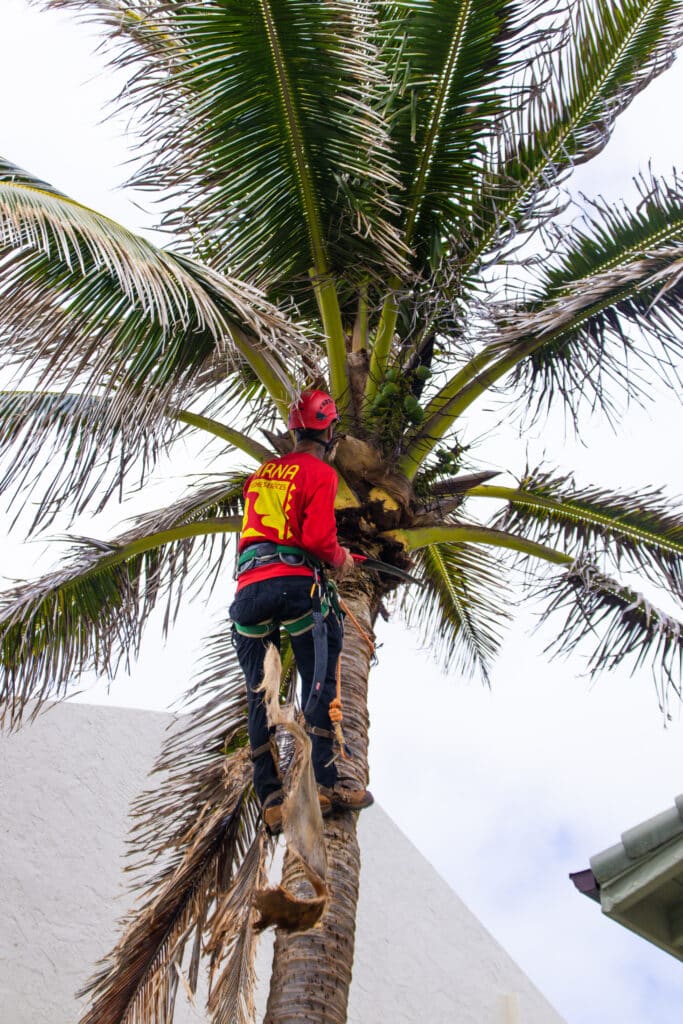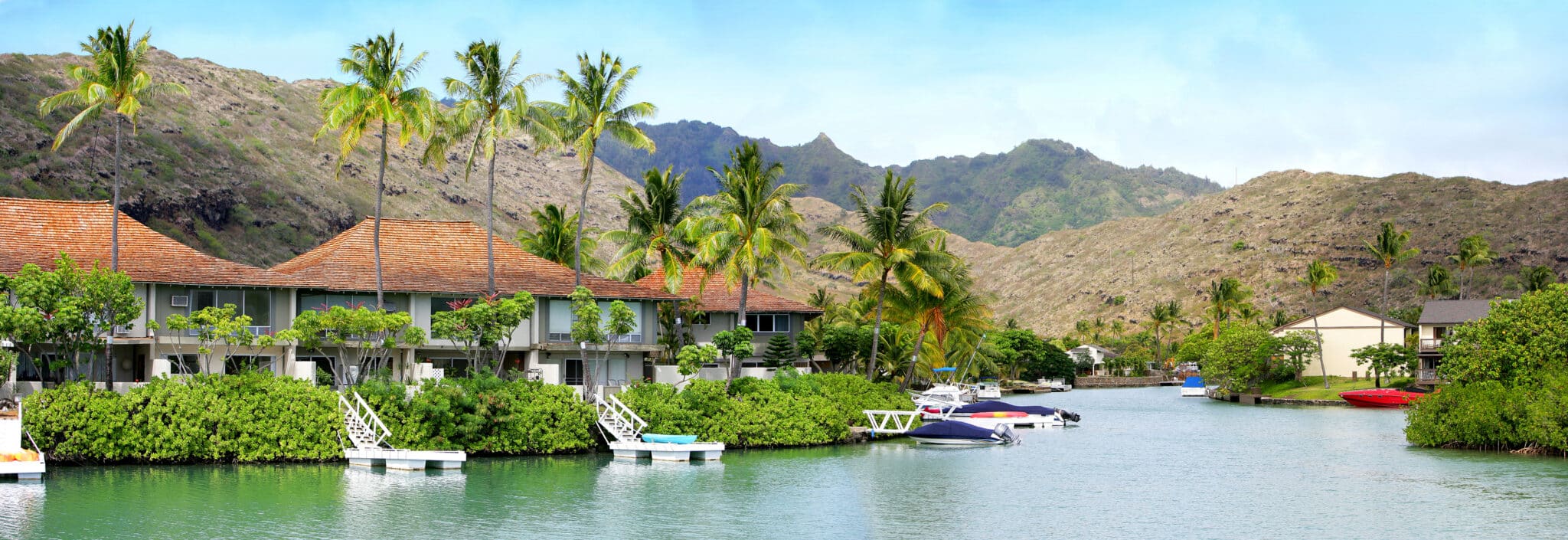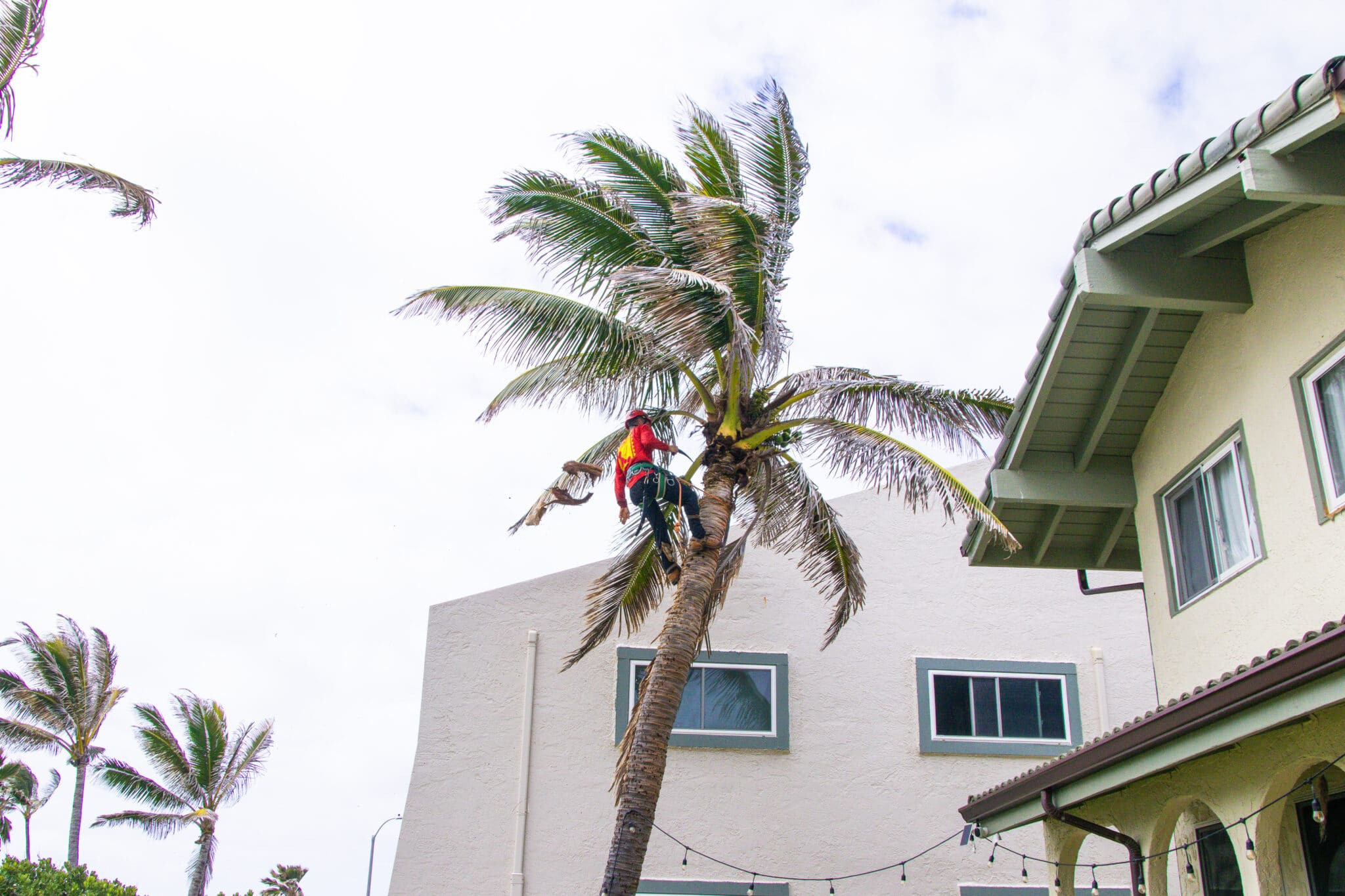As the summer heat approaches in Honolulu, the health and appearance of your palm trees become paramount. Pruning palm trees is not just about maintaining their aesthetic allure; it’s a crucial practice to enhance their resilience against the intense summer sun. For residents of Hawaii Kai, Waimanalo, and surrounding areas, understanding the right techniques and timing for pruning can make a significant difference. This guide aims to equip homeowners with the knowledge to properly care for their palms, ensuring they thrive throughout the hot, dry months.
Effective pruning helps in removing old fronds that may be draining energy from the tree, which is essential for promoting healthier, more vigorous growth. By focusing on removing only the necessary fronds, you can prevent over-pruning, which can lead to stunted growth or even disease. The process not only boosts the palm’s health but also significantly reduces the risk of fire, a critical consideration during Hawaii’s dry season.
Moreover, pruning palm trees correctly enhances the overall beauty of your landscape. It gives your garden a tidy, well-kept appearance that can transform your outdoor space. As we delve deeper into this guide, you’ll learn which fronds to remove, the best tools to use, and the optimal times for pruning, ensuring your palms are not only surviving but thriving under the summer sun.
By following the tips outlined in this guide, homeowners in Honolulu and beyond can prepare their palm trees for the challenging conditions ahead. Not only will this ensure the longevity and health of these iconic trees, but it will also enhance the curb appeal of your property. Stay tuned as we explore the specifics of pruning palm trees, helping you to keep your garden lush and vibrant throughout the season.
Table of Contents
ToggleUnderstanding the Basics of Pruning Palm Trees
Understanding the basics of pruning palm trees is crucial for maintaining their health and beauty, especially in areas like Hawaii Kai and Waimanalo. When you start pruning, it’s important to identify which fronds need removal. Typically, you should only remove fronds that are completely brown, hanging, or broken. This selective trimming helps the tree focus its energy on the growth of healthy fronds, enhancing its overall vitality and appearance.
The best time to undertake pruning palm trees is during the late spring or early summer before the peak heat sets in. This timing helps the trees heal better and reduces stress during the hottest months. By scheduling your pruning before the summer, you ensure that your palms are in the best shape to withstand the intense sun and dry conditions typical of Honolulu’s summer.
When pruning palm trees, using the right tools is essential for making clean cuts that heal quickly. Sharp, clean pruning shears, saws, or specialized palm tree trimmers are ideal. Ensure your tools are sanitized before use to prevent the spread of disease from one tree to another. This attention to detail will prevent damage and encourage a healthier regrowth.
Lastly, avoid over-pruning as it can severely affect the palm’s health. Removing too many fronds can stunt the tree’s growth and make it more susceptible to diseases and pest infestations. The goal is to preserve the tree’s natural shape and ensure it has enough fronds to maintain its health through photosynthesis. By following these basic guidelines, your palm trees will be well-prepared to thrive during the summer season.
Identifying the Right Time to Prune Palm Trees
Identifying the right time for pruning palm trees is crucial for their health and vitality, especially in tropical climates like Honolulu. Timing your pruning activities can significantly influence the tree’s ability to withstand the harsh summer conditions. For residents of Hawaii Kai and Waimanalo, the optimal period to start is late spring or just before the summer begins. This allows the palms to heal and acclimate before the temperatures soar.
Pruning too early or too late in the season can have adverse effects on palm trees. If pruned too early, the trees might not have enough time to recover and strengthen their defenses against the summer heat. Conversely, pruning too late can stress the palms during the hottest part of the year, potentially leading to sunburn or dehydration. Thus, timing your pruning right before the summer ensures that the trees are robust enough to face the intense sun.
The transition from spring to summer in Honolulu presents a unique opportunity to care for your palm trees. As the weather begins to change, keep a close eye on the forecast and start your pruning as the dry season approaches. This proactive approach helps in maintaining the structural integrity and aesthetic appeal of the palms, ensuring they remain a standout feature in your landscape.
Moreover, understanding the local climate patterns is essential when planning your pruning schedule. For those living in areas like Hawaii Kai and Waimanalo, it’s beneficial to monitor local weather updates and consult with gardening experts to pinpoint the best time for pruning. By aligning your pruning schedule with the local climate conditions, you can maximize the health benefits for your palm trees, ensuring they thrive throughout the summer months.
Tools and Safety Gear for Pruning Palm Trees
Choosing the right tools for pruning palm trees is essential to ensure clean cuts and prevent damage to the trees. Sharp, well-maintained pruning shears, saws, and specialized palm tree trimmers are crucial for effective pruning. These tools help make precise cuts that heal quickly, minimizing the risk of disease. Additionally, it’s important to sanitize these tools before and after each use to prevent the spread of pathogens from one tree to another.
Safety gear is equally important to protect yourself during the pruning process. Wearing gloves is essential to protect your hands from sharp fronds and rough tree bark. Safety goggles are also recommended to shield your eyes from possible debris when cutting high fronds. Furthermore, if you’re working on tall palm trees, using a sturdy ladder or a harness system can provide the necessary stability and safety, reducing the risk of falls.
Residents of Hawaii Kai and Waimanalo should also consider the environmental factors when selecting their tools and safety gear. Given the proximity to the ocean, choosing rust-resistant tools can be a wise investment. This not only extends the life of the tools but also ensures that they remain effective and safe to use over time. Additionally, considering the local climate and landscape can guide you in selecting the most appropriate safety gear that offers comfort and protection.
Lastly, storing your pruning tools and safety gear properly after use will extend their life and maintain their efficacy. Keep blades sharp and oiled, and store all equipment in a dry, clean place to avoid rust and degradation. By taking care of your tools and safety gear, you ensure that they are always ready for the next pruning season, helping you keep your palm trees healthy and your property looking beautiful.
Step-by-Step Guide to Pruning Palm Trees
Pruning palm trees is a delicate task that requires a step-by-step approach to ensure the health and aesthetics of your palms. Start by examining the tree closely to identify which fronds need removal. Focus on fronds that are brown, hanging low, or damaged, as these can sap the tree’s energy and detract from its appearance. It’s important to avoid cutting green fronds, as they are crucial for the palm’s photosynthesis and overall health.
Once you’ve identified which fronds to prune, prepare your tools. Ensure that your pruning shears or saws are sharp and clean to make precise cuts. This helps prevent disease and promotes faster healing of the cuts. For residents in Hawaii Kai and Waimanalo, using sanitized tools is particularly important due to the humid climate, which can foster the spread of pathogens.
Begin the actual pruning process by carefully removing the selected fronds. Cut each frond close to the trunk but be careful not to damage the trunk itself, which could harm the tree’s long-term health. Work from the bottom up, removing the oldest fronds first and gradually working your way to the higher, newer fronds if they require trimming. This method helps maintain the natural shape of the palm and ensures it doesn’t become top-heavy.
After pruning, it’s crucial to care for the palm to aid its recovery. Water the tree thoroughly, especially if the weather in Honolulu is trending towards the hotter, dryer spectrum. Applying a quality palm fertilizer can also support the palm’s recovery and boost its resilience against the harsh summer heat. By following these steps, your palm trees will not only survive but thrive, enhancing the beauty and safety of your landscape.
Identifying Which Fronds to Remove
Identifying which fronds to remove is a critical aspect of pruning palm trees effectively. It’s important to focus on removing fronds that are brown, drooping, or damaged. These are typically older and can drain energy from the palm, which is better used in supporting new, healthy growth. Residents of Hawaii Kai and Waimanalo should particularly note that removing these fronds not only helps in energy conservation but also reduces the risk of pest infestations, which are common in these humid areas.
When pruning palm trees, it’s also wise to remove any fronds that show signs of disease or fungal infection. These fronds can easily spread the disease to healthier parts of the tree if not promptly dealt with. Look for fronds with unusual spotting, discoloration, or wilting beyond normal aging. Removing these fronds helps maintain the overall health of the palm and prevents widespread damage that could result from untreated diseases.
Another key consideration is the removal of fronds that could pose a safety hazard. Fronds that hang too low or are broken can be dangerous, especially if located along walkways or near buildings. By removing these hazardous fronds, you not only enhance the safety of your landscape but also improve its aesthetic appeal. This is particularly relevant in areas like Waimanalo, where outdoor activities are frequent, and ensuring a clear, safe space is essential.
Lastly, while it might be tempting to prune more for a cleaner look, it’s crucial to avoid over-pruning. Palms should retain most of their healthy green fronds, which are vital for photosynthesis and overall tree health. A well-pruned palm should still maintain its natural shape and density. Over-pruning can stress the palm and make it more susceptible to diseases and weather-related stresses. Therefore, careful selection of which fronds to remove is key to successful pruning palm trees.
Techniques to Avoid Over-Pruning
Over-pruning is a common mistake in the maintenance of palm trees, particularly for enthusiastic gardeners in Hawaii Kai and Waimanalo. It’s crucial to understand that while removing dead or diseased fronds is beneficial, excessive cutting can harm the tree’s health. Palms rely on their fronds for photosynthesis, the process vital for their growth and nourishment. Therefore, a conservative approach should be adopted, focusing on the removal of only those fronds that are clearly damaged or dead.
To avoid over-pruning, it’s important to visualize the palm tree’s canopy as a clock face. A well-pruned palm should retain fronds from the 9 o’clock to 3 o’clock position, forming a healthy, full canopy. This technique ensures that the palm retains enough leaf surface area to continue its photosynthesis effectively. Removing too many fronds, especially those that are green and healthy, can starve the tree of its ability to generate energy, leading to weakened defenses and stunted growth.
Another effective strategy is the “less is more” approach. During each pruning session, aim to remove no more than 20% of the canopy at a time. This practice helps maintain the structural integrity and aesthetic form of the palm, while also ensuring it remains healthy and robust. By limiting the extent of pruning, you provide the palm with the best conditions to recover and flourish, especially during the intense summer months in Honolulu.
Lastly, regular monitoring and maintenance can prevent the need for drastic pruning. By keeping an eye on the health and growth of your palm trees, you can address issues promptly without resorting to significant cuts. This ongoing care not only preserves the natural beauty of the palms but also enhances their longevity and vitality. Remember, the goal of pruning palm trees is to support their health and growth, not to diminish it through over-pruning.
Benefits of Pruning Palm Trees Before Summer
Pruning palm trees before the summer season in Honolulu offers numerous benefits that extend beyond mere aesthetics. For homeowners in Hawaii Kai and Waimanalo, timely pruning can significantly enhance the health and resilience of palm trees against summer’s harsh conditions. By removing old and damaged fronds, trees are less likely to suffer from diseases and pest infestations, which are more prevalent during warm, humid months. This proactive measure ensures that your palms remain robust and healthy, ready to face the intense sun.
Moreover, pruning palm trees effectively reduces the risk of property damage and personal injury. During the summer, high winds and storms can cause weak fronds to break off, potentially leading to damage. By removing these vulnerable parts ahead of the season, you minimize the chances of fronds falling onto buildings, vehicles, or people. This aspect of palm care is crucial in maintaining a safe environment around your property, especially in residential areas where outdoor activities are common.
Aesthetically, well-pruned palm trees can transform the overall look of your landscape. They provide a neat, orderly appearance that enhances the visual appeal of your home. This can be particularly beneficial if you’re considering selling your property, as well-manicured landscapes are more attractive to potential buyers. Regular pruning keeps your palms looking their best, showcasing the natural beauty of your outdoor space throughout the sun-drenched months.
Lastly, pruning palm trees contributes to the overall ecosystem by promoting new growth and maintaining balance in the local flora. Healthy, well-maintained palms are better equipped to perform photosynthesis efficiently, which is vital for air purification and providing oxygen. Thus, by taking care of your palm trees, you’re not only enhancing your immediate surroundings but also contributing positively to the broader environmental system in Honolulu.
Aftercare Tips for Pruned Palm Trees
After pruning palm trees, it’s essential to focus on the aftercare to ensure they remain healthy and vibrant, especially in the hot, dry conditions of Honolulu’s summer. Proper aftercare starts with adequate watering. Palms may require more water post-pruning as they recover and seal their pruning wounds. However, be careful not to overwater, as this can lead to root rot. A deep, but infrequent watering schedule is ideal, encouraging strong root growth.
Fertilization is another crucial step in the aftercare of pruned palm trees. Applying a high-quality palm fertilizer can provide the necessary nutrients that help the tree recover and thrive. Look for fertilizers that are high in potassium, but also contain magnesium and iron. These nutrients are vital for the palm’s recovery and overall health, helping it to better withstand the intense sun and dry conditions expected in Hawaii Kai and Waimanalo.
Monitoring for pests and diseases after pruning is also vital. Fresh cuts can attract pests or become entry points for diseases. Regularly inspect your palm for signs of distress, such as unusual wilting, discoloration, or sap leakage. Early detection and treatment can prevent minor issues from becoming major problems, ensuring your palms continue to enhance your landscape’s beauty.
Lastly, maintaining the area around your pruned palm trees is important. Keep the base of the palms clear of debris and weeds, which can harbor pests or compete for nutrients. A clean surrounding helps in maintaining not only the health but also the aesthetic appeal of your palms. By following these aftercare tips, residents of Honolulu can enjoy lush, healthy palm trees that are a testament to well-executed pruning and diligent care.
Frequently Asked Questions
What are the benefits of pruning palm trees before summer?
Pruning palm trees before summer offers several advantages for homeowners. It promotes healthier growth by removing dead or damaged fronds, allowing the tree to focus its energy on new growth. This practice also reduces fire hazards by eliminating dry, combustible material before the dry summer months. Additionally, well-maintained palms enhance the aesthetic appeal of your landscape, making your property look tidy and vibrant as the season changes.
How often should you engage in pruning palm trees?
Pruning palm trees is best done at least twice a year to maintain their health and appearance. Typically, the optimal times are before the onset of the summer and winter seasons. This schedule helps prevent stress on the palms, allowing them to thrive during Hawaii’s intense summer heat and recover in the cooler months. However, it’s crucial to monitor your palms for signs of distress or overgrowth and adjust the pruning frequency accordingly to ensure they remain vibrant and robust.
What tools are essential for pruning palm trees effectively?
To effectively engage in pruning palm trees, a few essential tools are necessary. A sharp, clean pruning saw is crucial for cutting thicker fronds without damaging the palm. Long-handled loppers are ideal for reaching higher branches and making precise cuts. Safety gear, including gloves and goggles, protects against sharp fronds and falling debris. Lastly, a sturdy ladder ensures safe access to higher areas of the palm, allowing for thorough and efficient pruning.
Can pruning palm trees prevent pest infestations?
Yes, pruning palm trees can indeed help prevent pest infestations. By removing dead or dying fronds, you eliminate potential breeding grounds and hiding spots for pests like beetles and mites. This practice also improves air circulation throughout the palm, which can deter pests and reduce the risk of fungal diseases. Regular pruning keeps the palm trees healthy and less susceptible to invasions, maintaining their resilience against pests during Hawaii’s warm months.
What are the common mistakes to avoid when pruning palm trees?
When pruning palm trees, it’s crucial to avoid common mistakes that can harm their health and growth. Over-pruning is a frequent error; removing too many fronds can stress the palm and stunt its development. Another mistake is cutting too close to the trunk, which can create wounds that expose the tree to diseases and pests. Additionally, using dirty or dull tools can tear fronds and introduce pathogens. By avoiding these pitfalls, homeowners can ensure their palm trees remain healthy and attractive.




